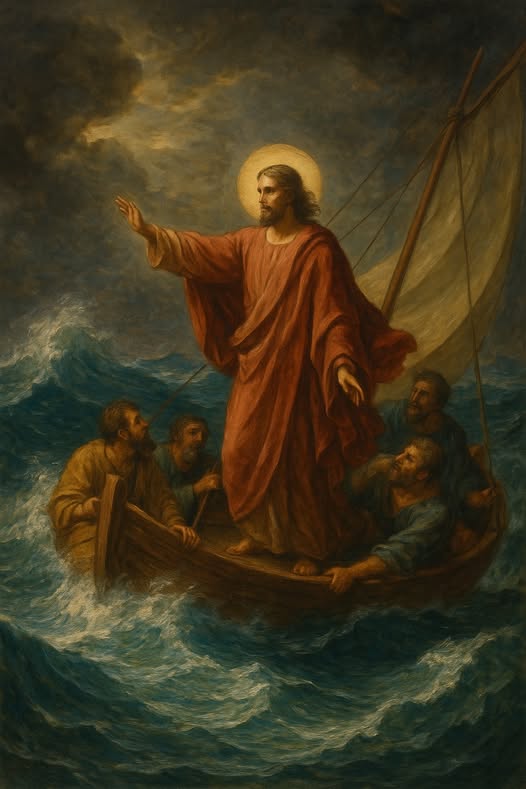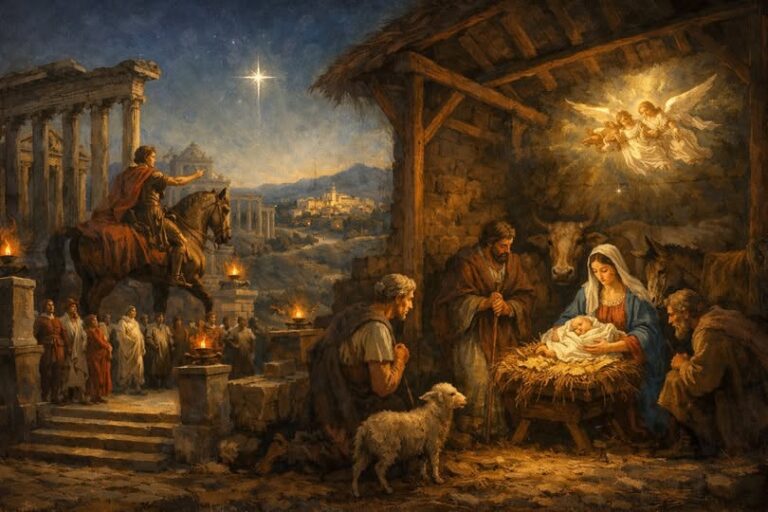
One of the most striking miracles recorded in the Synoptic Gospels, Matthew 8:23–27, Mark 4:35–41, and Luke 8:22–25, is the calming of the storm on the Sea of Galilee. This moment is not just a demonstration of supernatural power. It is a revelation of Jesus’s divine identity, a confrontation with ancient chaos motifs, and a theological statement about who truly rules creation.
The Setting: A Storm on the Sea
The narrative begins with Jesus and His disciples crossing the Sea of Galilee. As they sail, a sudden and violent storm overtakes them. The waves batter the boat, and seasoned fishermen among the disciples are gripped by fear. Meanwhile, Jesus is asleep in the stern, physically exhausted but undisturbed.
His sleep underscores two realities. First, it points to His humanity, He was tired from ministry. Second, it reveals His absolute trust in the Father’s care, even amid chaos.
The Miracle: Peace, Be Still
Panicked, the disciples wake Him, crying out for help. Jesus rises and speaks a simple command: “Peace, be still.” Immediately, the wind stops. The sea becomes calm. What moments before was a scene of terror turns into stillness.
Jesus then turns to His disciples and challenges them, asking why they are so afraid and why their faith is lacking. Their response is one of awe and fear. They marvel, asking, “Who then is this, that even the wind and the sea obey Him?”
Confronting Chaos and Divine Rivals
To the modern reader, this might seem like just a nature miracle. But for an ancient audience steeped in the worldview of the Ancient Near East, this was far more than meteorological mastery.
The sea was a symbol of chaos, disorder, and untamed power. In the Old Testament, only God has the authority to still the seas. He does this at creation (Genesis 1:2), during the Exodus (Exodus 14:21), and in poetic reflections like Psalm 89:9 and Job 26:12.
Moreover, this moment functions as a subtle polemic against Baal, the Canaanite storm god who was said to control wind, sea, and weather. Baal’s battles in the Ugaritic texts depict him struggling with the chaotic sea deity Yam. In contrast, Jesus does not battle the sea, He commands it and it obeys. There is no contest. The authority Jesus demonstrates belongs only to Yahweh. This miracle, then, is a direct revelation that Jesus is not merely a prophet or teacher. He is acting in the role of Yahweh Himself.
Divine Council Implications
Within the Divine Council worldview, this moment reveals Christ’s superior position over all spiritual beings who were once thought to govern aspects of creation. The calming of the storm is not just about physical safety, it is about Jesus exercising dominion over forces that ancient cultures considered divine. Where Baal needed the permission of El and fought long battles to prove his right to rule, Jesus speaks once, and the storm obeys. This act asserts His unique place not only within Israel’s theology but within the heavenly hierarchy.
A Transformative Moment for the Disciples
The disciples began this journey fearing the storm. They ended it fearing the One who calmed it. Their fear turned from the natural to the supernatural, from the created to the Creator. This event reshaped their understanding of who Jesus truly was. It also prepared them for the trials ahead. If the winds and waves submit to Him, so too can their lives be entrusted to His care.
Why it still matters
For modern believers, this story is more than an ancient event. It speaks to every moment of fear, chaos, and doubt. When life becomes overwhelming, and we feel tossed about by forces beyond our control, Jesus’s words echo across time: “Peace, be still.” He remains the one with authority over both nature and the unseen powers that lie beneath it. The calming of the storm reassures us that no force, physical or spiritual, can overcome the One who rules over all.
Conclusion
The calming of the storm stands as more than an isolated miracle. It is a theological declaration that Jesus is the Creator who subdues chaos by His word alone. Every ANE myth portrayed order as the result of divine conflict, but the Gospel reveals peace as the product of divine authority. Where other gods struggled against the sea, Christ commands it without effort. Where pagan deities sought dominion through violence, He rules through presence and word.
The disciples witnessed what no ancient myth could ever imagine: the true Lord of heaven and earth standing within creation, speaking calm into chaos. For believers today, that same voice still speaks. The One who tamed the waters of Galilee continues to bring peace to every storm, revealing that He remains the sovereign over both the visible and unseen realms.
Discussion Questions
- How does the miracle of calming the storm serve as a revelation of Jesus’s divine authority rather than just a demonstration of power?
- In what ways does this story confront the ancient belief systems surrounding Baal and other storm deities?
- How does understanding the Divine Council worldview deepen the theological impact of this miracle?
- What does the disciples’ reaction to Jesus’s command over nature reveal about their evolving faith?
- How can this story help believers today respond to fear and uncertainty in their own lives?
Want to Know More?
- The Unseen Realm by Michael S. Heiser
Explores the Divine Council worldview and explains how Jesus’s miracles, including control over nature, fit within the broader theological framework of Old Testament imagery and spiritual authority. - Against the Gods: The Polemical Theology of the Old Testament by John D. Currid
Examines how biblical authors frequently subvert and challenge pagan ideas, including storm-god mythology, in texts like this one. - The Gospel of Mark (NICNT) by William L. Lane
A scholarly yet accessible commentary on Mark’s Gospel that provides historical and cultural context for miracles like the calming of the storm. - Yahweh Versus Baal: A Conflict of Divine Authority by Thomas R. Bennett
Explores how biblical texts directly confront and reverse the narratives of Canaanite theology, especially Baal’s supposed power over the sea and storm. - Echoes of Scripture in the Gospels by Richard B. Hays
Traces the deep Old Testament allusions found in the actions and teachings of Jesus, including His control over the waters.




